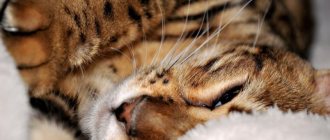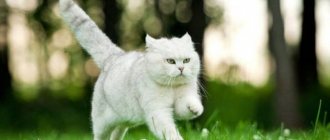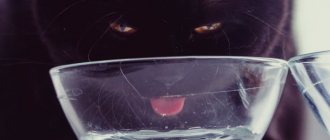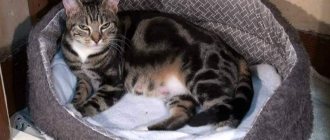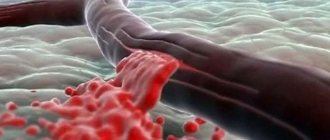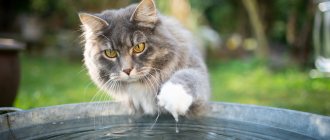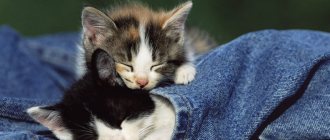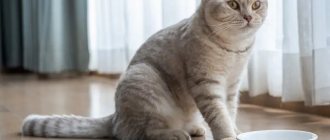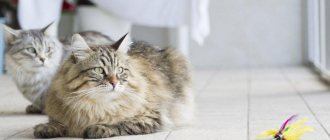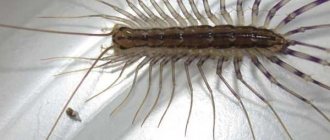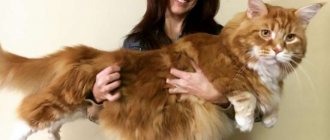Like humans, cats can survive for some time without food, but no pet can survive for long without water. Prolonged lack of water has a negative impact on health, leads to negative consequences and can cause death. However, the animal body is structured somewhat differently than the human body. An animal is guided by instincts, not desires, so a cat may voluntarily refuse to drink for some time, and there are many reasons for this.
Cat and water standards
The most important thing that a cat’s body needs is clean and high-quality water in sufficient quantity for normal life, which depends on:
- Ambient temperatures. During the hot season, your pet drinks much more than in winter, spring or autumn.
- Diet. A pet on natural food gets some of its moisture from food - meat, cereals, dairy products. Dry industrial mixtures (high class) contain all the necessary substances in sufficient quantities, but increase thirst.
- Breeds. Some individuals, due to the characteristics of their organism, manage with a small amount of liquid, for example, the British or Scottish fold. Others drink water often and in large quantities. These varieties include the Bengal cat.
- Individual characteristics. The age of the cat and its state of health also significantly affect the amount of fluid consumed by the animal. Typically, the older the pet, the more he drinks.
A cat's body contains about 70% water. The average fluid intake per day for an adult is from 200 to 300 ml.
It has been established that the maximum period a pet can go without drinking without disrupting the normal functioning of the body is two days. Further dehydration quickly weakens the animal; after five days of a dry diet, the cat may die.
Dangers of no water intake
Not eating is bad, yes. But lack of hydration can get worse and faster. It is very important to make sure that your cat gets fluids in any way possible so that she will accept it. Not drinking for long periods of time can cause irreversible problems and wreak havoc on their body.
Your cat's body is made mostly of water, just like ours, and makes up more than 80% of its being. Every organ, tissue and vessel needs water to function. Cats are already prone to dehydration, so not drinking completely is very bad for them.
When your cat stops drinking, her condition will quickly worsen and she will begin to suffer from dehydration. The longer the body goes without fluid, the more organs begin to shut down one by one. Their body will stop the flow to the less important organs first, making sure the most important ones continue to function.
The more fluid is lost, the more organs fail. By the third day of no water, the body will completely shut down. If your cat refuses to drink, your veterinarian may need to administer intravenous fluids to prevent permanent organ damage or death.
How long does a hunger strike last?
According to veterinarians, cats can live without food for a maximum of a week. But these indicators differ from each other, because it all depends on:
- The age of the cat.
- Breeds.
- The state of her health.
- Endurance.
- The amount of fat under the skin.
There is another statistic that shows how long a cat can live without food and water:
- kitten up to 6 months – less than a day;
- teenage cat – 1-5 days;
- cat from 7 years and older – 3 days;
- a cat suffering from any disease – 2 days maximum.
If a pet does not eat for more than two weeks, the consequences are already irreversible. Lethal outcome is guaranteed.
A person is 80% water, and a cat is 70%. If during a hunger strike he does not replenish his water reserves, then he will not be able to live long. He will die from lack of water faster than from lack of food . The norm for a typical adult cat per day is about 300 ml of water. If the percentage of fluid in the animal’s body is at least 60%, everything will end in death. 5 days without water is the maximum amount of time for cats.
On the 6th day, the hair falls out, the cat lies in place, and the eyes do not open for most of the day.
How to convince your cat to eat or drink
There are a few things you can try at home before visiting the vet to encourage your cat to eat or drink. Depending on the actual cause of the symptom, you can feed and drink water, even if it is a small amount.
But these methods do not replace the attention of a veterinarian. Chances are, if your cat refuses to eat or drink, something terrible is happening that will require further monitoring and treatment.
© shutterstock
Causes and timing of fasting
Many cat owners have experienced short-term refusal of their pets to eat. This can happen for a number of reasons:
- If a family moves from one climate zone to another, this may affect the cat's condition. Acclimatization usually takes about two days, and she begins to eat again.
- The change of seasons and temperature also affect the pet's appetite. In summer, in the heat, it is usually reduced, and thirst is stronger. During cool and cold periods, the cat eats with pleasure, but drinks less. Complete fasting usually does not exceed two days.
- A quick transition to a new food or diet can also trigger a complete refusal to eat. If this process occurs gradually, hunger strike usually does not occur.
- The quality of food is of great importance. The cat will never eat spoiled food. A dirty bowl containing rotten food can also trigger complete failure.
- In case of poisoning, the cat can independently arrange fasting days, which are necessary for the natural cleansing of the body and the resumption of its normal functioning.
- Unexpected mood swings that cause fasting are also common, unless they last more than a day or two.
- A pet's hunger strike can be caused by severe stress, triggered by the loss of its owner, injury, meeting other pets, or moving.
- The reason for a short-term refusal to eat may be hormonal changes in the body. It occurs during the rut, mating, pregnancy, and childbirth.
- After any operation performed under anesthesia, for example, sterilization or castration, the pet may completely or partially refuse to eat until the body recovers.
- Usually, a complete hunger strike also occurs when an animal is bitten by a tick or has a helminthic infestation.
- Often, loss of appetite is caused by illness.
What to do?
If a domestic cat does not want to eat or drink for natural reasons, then you need to wait out this period. Usually it lasts no more than 2 days.
The animal needs help. Give him attention, take care, sometimes you can even feed him with a spoon so that the pet feels that he is loved. If there is a problem with changing food, it is recommended to choose the right diet and consult a veterinarian. You can leave the old food and slowly replace it with new food.
When a cat is sick, it loses its appetite and desire to drink. There are serious diseases that are fatal. Therefore, at the first signs of illness, you should consult a doctor. He will prescribe examinations and treatment. It’s better to play it safe, make a timely diagnosis and treat your little pet so that he is healthy and brings joy to his owner for many years.
Automatic feeder
It happens that a cat’s owner needs to leave for a few days. But the pet must receive food at least once a day. In this case, an automatic feeder helps. It is equipped with a feed timer and is quite spacious.
The material is completely safe for the animal and the feeder can be used for a long time. With its help, you can provide food for a cat for several days. The design is a container divided into several parts. Battery operated. The owner sets the timer for feeding the feed the required number of times a day.
Outdoors in winter without food: cat endurance
How long a cat can live outside without water and food in winter largely depends on the strength of the animal’s body. Some hardy individuals are able to survive almost a week without much harm, while other delicate creatures die within a few hours. It all depends on how quickly the pet can adapt to cold and hunger and learn to get its own food.
Cats can tolerate sub-zero temperatures quite easily. However, for this it is important for them to receive a normal amount of food and timely drinking. Therefore, many pets are doomed. For example, it is strictly unacceptable for sphinxes to be outside even for a short time, since cold weather and drafts are destructive for them.
The main difficulty associated with a cat’s survival on the street is that it is difficult for it to find water; cats, unlike dogs, cannot eat snow. This is why a pet that is not adapted to survive in harsh conditions can die within 6-10 hours.
Mr. Cat recommends: how to help
If a pet refuses food for more than two days, then first of all it is necessary to establish the cause of the hunger strike and try to eliminate it, if possible. During this period, it is extremely important to take the following measures:
- Ensure constant access to clean drinking water.
- Try to arouse the animal's appetite by holding a strong-smelling treat to its muzzle.
- Prepare your pet’s favorite dish and heat it to just above room temperature.
- You can try to feed the cat using a teaspoon or from the palm of your hand. A small kitten is given liquid warm food through a syringe without a needle - starvation is especially dangerous for him.
- It is advisable to drop a few drops of a special product into the water that stimulates the appetite of cats. It is sold in veterinary pharmacies.
If all else fails and the hunger strike continues, you should take your pet to a veterinary clinic.
This must be done immediately if:
- refusal to eat for more than two days;
- dry hunger strike - the cat does not eat or drink;
- signs of dehydration are observed - the coat looks oily, the nose is dry and soft, and general lethargy and lethargy are noted.
If a disease is detected and treatment is prescribed, but the animal’s appetite does not return, the cat is forcibly fed (in agreement with the veterinarian) with liquid food - baby meat puree or special medicinal wet mixtures, kefir, fermented baked milk, chicken broth.
How does hunger affect the body?
Everyone has probably seen stray dogs and cats on the street. Their appearance is often frightening, thin, with protruding bones and sunken eyes.
stray cat
Please note that the digestive systems of dogs and cats are different. Dogs are relatives of wolves and their bodies are adapted to fasting for a large amount of time. But things are different for cats. Felines eat often and in small portions, so when there is a lack of food, the body experiences great stress. It is known that fat is broken down in the liver. If food is not supplied for a long time, the liver will process more fat. And she will no longer cope with such a load. This will give rise to the development of diseases. The kidneys and liver are primarily affected. And if the refusal to eat drags on for a long time, then nutritional dystrophy occurs, in other words, depletion of the body from which all organs, without exception, suffer.
First aid
If you don’t have time to visit a veterinary clinic, you can try to help the animal yourself, provided that it is not seriously ill. If the refusal of food is due to the nature of the cat, then you can do the following:
- As cats age, they lose their sense of smell. Lead the cat to the bowl and hold it there. Perhaps the sight of food will make him want to eat.
- Feed your cat his favorite food, something he has never refused or something he finds difficult to live without.
- Warm up the food and hand feed your cat, but do not force the food into his mouth. When it comes to small kittens, feed them with a spoon or syringe.
- The veterinary pharmacy sells special medications to improve appetite. Try them.
How to encourage eating and drinking
To keep your feline ready to feed, you can try to satisfy his deepest desire - smelly wet food. The more it smells, the more the taste buds are stimulated.
While you shouldn't be in the habit of giving your cat canned tuna or wet cat food, desperate times call for desperate measures. Anything you can get your cat to eat until she gets to the vet is better than nothing at all.
Consequences of fasting
Long-term refusal of food and water cannot do without consequences. Their effect on the animal’s body depends on many factors:
- pet's age;
- size and weight before the hunger strike;
- general health;
- reasons and duration of refusal.
If the pet is lost and returns a month later in a very emaciated state (or it is an emaciated cat picked up on the street), in no case should you give a lot of different food at once.
Such an animal should be fed in small portions, often in fractions, and preferably with wet food.
Prolonged starvation and exhaustion of a cat can lead to the following:
- Significant weight loss.
- Decreased wool quality - the formation of tangles and bald spots, hair loss, unkempt appearance.
- Loss of strength and decline in the overall tone of the body - sometimes the cat does not even have the strength to stand up.
- Deterioration of vision.
- Apathy, lethargy, desire for solitude.
- Problems with the gastrointestinal tract, kidneys, liver. They manifest themselves in the form of nausea, vomiting, constipation, and diarrhea.
- Decreased immune defense of the body. Frequent colds and respiratory diseases may appear.
We recommend reading the article about vitamin deficiency in cats, which can be caused, among other things, by prolonged fasting.
It is advisable that the condition of an emaciated animal be assessed by a veterinarian. At first, you may need to support your pet with vitamin injections or intravenous infusions of special solutions. The specialist will also help you choose the right diet to quickly return the animal to a normal, fulfilling life.
Consequences of not eating
Here are a few factors that influence the consequences of not eating and drinking:
- Age of the cat;
- Weight;
- Causes and duration of hunger;
- Health status.
But look at the consequences of long-term abstinence from cat food:
- Weight loss.
- Prostration. It is difficult for the cat to get up and move around. If she moves, it is very slowly and not confidently.
- Hair loss, mats.
- Visual acuity is lost.
- Constipation, kidney failure, gastric ulcers.
What affects the rate of dehydration
Cats are not such whimsical creatures as humans. Even a small puddle can serve as a source of drinking. Therefore, in nature, felines rarely die from its lack. Speaking about home life, sources of drinking can be a dripping faucet, toilet, plants.
It is impossible to say exactly how long a cat can go without water, since individuals can be strong and can withstand up to 10 days.
You can only start from the average value. Therefore, single owners should take care of what will happen in the event of force majeure.
How long can a cat live without water?
All living organisms consist almost entirely of water, in the case of a cat - 70%. A decrease in this level by 10 percent or more triggers the development of irreversible processes that end in death. So how many days can a cat live without water? A young, healthy individual can live no more than 5 days without consequences for the body. Elderly individuals and kittens can withstand a little more than 24 hours in the absence of liquid.
How long after giving birth can a cat become pregnant?
The body's water balance is affected not only by age, but also by climatic conditions. For example, in hot weather the need for water increases, in winter it decreases slightly. The type of food matters: dry food requires more fluid intake, and a noticeable desire to drink begins after 24 hours.
Experienced cat owners not only change water daily in convenient wide bowls, but also leave water containers around the perimeter of the apartment or an open toilet lid in case of unforeseen circumstances. With water that has settled for several days, you can water your indoor plants.
Additional Information! Pet stores sell automatic drinking bowls for cats that fill the bowl with water as it becomes empty.
Automatic cat waterer
When to contact a veterinarian urgently
Prolonged hunger strike is a process that has a significant negative impact on all vital systems of the cat. Thus, it is necessary to highlight the most dangerous conditions. In case of occurrence of which it is necessary to urgently show the animal to a highly qualified doctor:
- If the animal begins to splash out the infused liquid.
- The cat's nose becomes warm and very dry.
- If there is a significant increase in your pet's body temperature.
- Symptoms of diarrhea or vomiting are observed.
- General anger of the body or failure to respond to any signals.
If you notice that your pet has suddenly lost his appetite or is refusing to drink fluids, then you should immediately consult a veterinarian. Only a professional will be able to establish the main cause of this condition and recommend the main ways to eliminate it. If you pay due attention to your pet, its health will be strong and its condition stable.
Reasons why cats may stop eating
Cats can be finicky creatures. The reasons why they stop eating may be emotional or physical. Most often, cats stop eating for one of the following reasons:
- Depression or anxiety – If your cat loses a close friend or caregiver, she may quickly become depressed. Although this is usually temporary, it can cause real harm if they refuse to eat or drink for too long. Sometimes worrying about a recent change can have the same effect.
- Dental problems . If your cat is suffering from a toothache, she may not want to make it worse by eating. If you know your cat has bad teeth, you can take a closer look to see how bad the situation is.
- Fundamental Disease . Feeling somewhat unwell may cause your pet to lose its appetite in general. There can be many reasons, such as cancer, kidney failure or infections.
Your veterinarian will be able to physically examine your cat and run any necessary tests to rule out possible problems.
What kind of water is considered healthy?
The quality of water also affects the health and life expectancy of a cat. The best option is soft and purified water at room temperature.
It is recommended to give it filtered or frozen.
It is better not to give them tap water, as it may contain a large number of different impurities. Cats especially should not drink from the aquarium and toilet.
Pour the liquid into a special container, wash and change the water daily. In addition, you can add various supplements, such as tuna juice (the smell will attract), iodine, fluoride, nutritional drinks for cats.
The importance of water for the cat's body
Liquid plays a big role in the life of an animal. The body consists of 70% water, but despite this, it must be regularly supplied to the body.
Thus, it performs a number of functions:
- Oxygen and nutrients are transported from cells to the blood.
- Involved in regulating body temperature.
- Protects and protects internal organs.
- Removes metabolic waste.
- Facilitates food absorption and digestion.
- Removes toxins and impurities.
In addition, very often a lack of water in the body causes urolithiasis. It is especially common among neutered cats.
Photos of cats
Read here Cat aggression - expert advice on how to correct excessive aggression in a cat (105 photos and videos)
Help the site, share with friends 
What to do if the cat doesn't eat
In each specific case, when a cat has stopped eating its favorite food, the behavior of the owners and treatment should be individual and justified.
The first rule is that you should not try to force feed an animal until you have found out the exact reason for the hunger strike.
Feeding with a syringe or spoon is allowed only as prescribed by a doctor. Only a veterinarian can make an accurate diagnosis. If the doctor identifies a disease, he will prescribe treatment.
Tips for caring for a cat
It’s not worth experimenting on your pet and finding out how long a cat can live without water. Pets at home are completely dependent on their owners.
- Animal Raccoon - species, habits, interesting facts about life in the wild
Cat repellers - what they are and how they work. Prices, models and manufacturers of safe and effective devices (135 photos)
Cat aggression - expert advice on how to correct excessive aggression in a cat (105 photos and videos)
To prevent dehydration, there are a number of standard care recommendations:
- The animal's bowl must be washed every day.
- It is not advisable to give boiled water, as it is devoid of useful minerals.
- Running city water should not be provided as it contains chlorine and metals.
- You need to monitor your water consumption every day.
- It is imperative to provide an additional source of water in case of force majeure. A special drinking bowl will help solve the problem.
Even following these simple rules will help your pet live a long and happy life.
Today in specialized stores you can purchase any device that will make caring for your cat easier. You can make a drinking bowl with your own hands, the main thing is that your pet gets something to drink.
